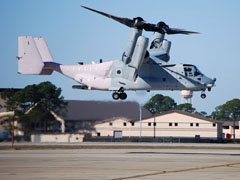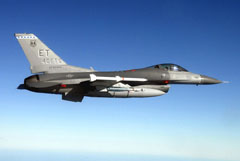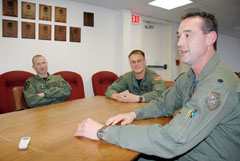
| Developmental Test
Pilots First Step in Advancing the Warfighter |
|||
|
3/12/2009 - What the movie "Top Gun" did for fighter pilots, "The Right Stuff" did for test pilots. But developmental test pilots at Eglin Air Force Base say test flying has come a long way since the early days depicted in the movie. "Most people think we're all Chuck Yeager" said Lt. Col. Geno Wagner, 413th Flight Test Squadron commander. Retired Air Force Maj. Gen. Chuck Yeager, a former test pilot, was the first man to break the sound barrier in 1947 and set several other speed and altitude records. "They think we're cowboys and wear space suits." That idea, in part, is what drew retired Lt. Col. Andy White to the career field. "When I first went to test pilot school, I thought I'd get to do all these cool things with new airplanes that nobody's ever done before," said Mr. White, former commander and now civilian test pilot with the 413th FLTS. In fact, Mr. White was the first test pilot to drop the GBU-43B, known as the Mother of All Bombs in 2003. "But there's a lot of time that I spend flying around in circles - same altitude, same airspeed." Today's developmental pilots are not the adrenaline junkie, hot shots taking on deadly test missions, but studious, methodical engineers. While testing new weapons, software and airframes will always have an element of danger, everything is tested, measured and put through hundreds of simulations on the ground before it is put in the air. "Safety is a big part of what we do," said Maj. James Stahl, 413th FLTS assistant director of operations and test pilot. "We mitigate risk probably better than anybody," said Colonel Wagner. "We don't fly with 'no' risk, we fly with 'known' risk." THE MISSION Developmental test pilots certify that weapons do what they are supposed to, and test new weapons and software to ensure the contractor satisfies the requirements. For instance, Air Combat Command will set requirements for a new capability, such as a missile, radar integration software or a guidance system on a bomb. The test pilots are involved early in the process with the contractor building the capability so they can figure out how to test it and what criteria should be used to judge its success. It's during these times the more methodical chores are broken up with the test pilots pushing a new system to the limits of its capabilities - called the envelope. "In developmental testing, we're certifying an envelope, so we'll say the new capability can go to these speeds and survive, and won't shake the aircraft apart," said Maj. Kyle Kolsti, 40th FLTS assistant director of operations. "Our primary task is to make sure the capability meets the specifications set forth and it can be safely carried within the envelopes the user requires." THE 40th FLTS The 40th FLTS employs 21 aircraft in testing; F-15s, F-16s, A-10Cs and UH-1 helicopters. They test many of the weapons used by military aircraft down range, such as the JDAM (Joint Direct Attack Munition), SFW (Sensor Fuzed Weapon), the SDB (Small Diameter Bomb), AMRAAM (Advanced Medium Range Air-to-Air Missile) and the AIM 9X (Sidewinder missile). "Since we are part of the Air Armament Center, we are fortunate enough to be involved in the development and improvement of weapon systems," said Capt. Matt Phillips, 40th FLTS F-16 assistant flight commander. "These weapons are critical to the warfighter." Weapons testing encompasses everything from how munitions bolt onto the aircraft to whether it successfully engages the target. The flight test squadrons determine whether it works. After rigorous developmental testing, it is handed off to operational test pilots for further testing in a combat or operational scenario. The tests commonly flown by the developmental test pilots are separations, compatibility flight profile and flutter testing. Separations testing analyzes all aspects of weapons that separate
from an aircraft. This build-up testing is designed to minimize risk when the new capability is tested in the air. Next, the pilots test the weapon in flight to ensure the weapon separates cleanly without impacting the aircraft and "to see if the bomb tumbles, fishtails or does other things they weren't anticipating," Major Kolsti said. Chase aircraft and the test aircraft itself record the event on camera or video. Flutter testing is another important aspect of the weapons test program. Flutter testing deals with stores, which are any items hung off the wing of an aircraft. Weapons, brackets, pylons and pods can interfere with the airflow over the wing, and at certain speeds and altitudes, the wing and the stores vibrate. The aircraft and weapon's structure can break or the vibration can be so violent that the pilot can't perform his mission. "You can see the wing bouncing up and down rapidly, and it feels like you're driving over railroad tracks," said Major Kolsti. "We slowly accelerate at different altitudes until it reaches a point where it's out of limits. That's how we establish the envelope operational pilots will be allowed to operate with the munition." The third type of weapons testing is called Compatibility Flight Profiles. This is where test pilots "push the envelope" or establish safe limits for the new capability in flight. During these missions, aircraft and weapons are taken to the limit with high-G pulls, high-G bunts, where the nose is suddenly pushed down, and loaded rolls, where the aircraft rolls from side to side to transfer G forces to the opposite side. These missions can last more than three hours and require in-flight refueling. "I've seen test points where we have to climb to 50,000 feet and then put in the afterburner and dive down to reach a high-speed test point," Major Kolsti said. "And then we're out of gas," he said. "If we didn't have a tanker, it could take up to eight flights to complete one of these test sorties." The 40th FLTS also test airframes, flight controls, engines, avionics software and sensors. They test all software development for active-duty F-15s, and conduct most testing for the A-10C Warthogs. The A-10 Warthogs received a major modification upgrade for use in the current Global War on Terror. "We helped develop the A-10C," said Lt. Col. Evan Dertien, 40th FLTS commander. Along with the contractors, the squadron tested a complete modernization of avionics for the aircraft and the technology to drop precision-guided munitions. It now has modern electronic displays that include global positioning system, moving maps and integrated targeting technology. COLLECTING DATA Modernization of the aircraft is necessary to collect test data. Test aircraft are specially instrumented with cameras and telemetry that is monitored by engineers in a control room on the ground. "The engineers see the heads-up display video - the parameters, air speed and altitude - just as we do in the cockpit," said Major Kolsti. "They're collecting all kinds of data in the background. While the pilots fly test points, the engineers let the pilots know when the test point is met or they may decide when it's too dangerous to continue. This is an important safety measure in flutter testing because the engineers have more information than the pilot on the weapon and measurements of the wing's vibration. The squadron's UH-1 helicopter pilots stay busy testing the airframes and its capabilities as well as testing capabilities for other aircraft early in the test process. For instance, if a navigation system needs to be tested before they can continue perfecting a new capability for an F-15, they can first fly it on the helicopter. This gives the contractors an opportunity to refine their software or weapon before flying it on a more expensive airframe. "To fly it on an F-15 costs about $15,000 an hour," said Colonel Dertien. "A helicopter costs less than $1,000 per hour." The 413th FLTS The 413th FLTS has the same mission, but it's located at Hurlburt Field because it flies developmental test missions on special operations aircraft, like the various models of the C-130 and the CV-22 Osprey. The squadron has seven test pilots flying 16 different aircraft models, although it only owns two - a CV-22 and a C-130. That means they borrow a lot of aircraft from other squadron for tests. "One of the things that make us unique is that a lot of us are attached to operational flying squadrons," said Mr. White. "We fly with combat units when they do local training, maintain combat mission ready status and can deploy with operational units if required." No other test squadron allows their pilots to do this. "This gives us more credibility with AFSOC, and makes us operationally relevant testers," added Major Stahl. Unlike the fighter jets that are either single- or dual-seaters, the C-130 and its' many variations typically takes a crew of five to fly, and the CV-22 typically requires three crew members. So not only do the test pilots use the combat aircraft stationed at Hurlburt for testing, but also the operational crewmembers to assist with flights. "When I'm out testing a new software load for the MC-130H and I'm the test pilot, I've got a flight test engineer, and the rest of the guys onboard the aircraft are operational crew members," he said. Mr. White said having operational crewmembers aboard is advantageous because developmental test pilots no longer fly real world missions. The crewmembers who fly in combat speak up if they think something they're testing won't work in theater. "It gives us a good idea of how (operational crews) are employing the airplane and the way they use the systems," Mr. White said. "Guys stationed at Edwards or other units physically removed from operational units don't have the same day-to-day access we do with our ultimate customer." The 413th FLTS tests weapons, software upgrades, radar and warning systems like terrain-following and collision avoidance systems. One of the unique capabilities they've been working on is the Advanced Tactical Laser, a directed energy weapon to be shot from the belly of a C-130. "It will be the first time anyone has ever shot a laser from an aircraft and blown up something on the ground," Colonel Wagner said of the chemical laser. "We're the first guys that get to do that." "And that's what everybody hopes for," said Maj. Solomon Baase, 413th FLTS test pilot. "... to go out and fly a new system or do a first-time test. That's when you really feel like you're the tip of the spear and pushing the envelope." The squadron's two CV-22 test pilots have been working on testing a defensive gun for the tilt-rotor aircraft that was meant to operate as an offensive weapon. "The (AC-130H) gunship was built for that, but the Osprey was never meant to have it," said Maj. Karl Seekamp, 413th FLTS CV-22 test pilot. In addition to the Ospreys, they also test other helicopters and plan to test new search and rescue helicopters in April. "We are the only helicopter testing squadron in the Air Force," said Major Seekamp. EDUCATION AND TRAINING Most all developmental test pilots are Test Pilot School graduates. The pilots start out as operational pilots and work their way up in the pilot hierarchy to instructor pilot. To be considered for Test Pilot School, they must have an engineering degree. Once pilots graduate, they stay in the developmental test or acquisitions for the rest of their career. The school lasts one year and is focused on four areas; performance, handling qualities, systems and test management. They learn to fly about 20 to 25 different military airframes during that time; one of the bonuses that attract some to the field. "The really cool thing about developmental test pilots is we can fly any aircraft in the Air Force inventory and log time in it," Colonel Wagner said. "That's the whole point of the school," Major Baase said. "They put us in so many different airplanes that you break it down to an airplane is an airplane is an airplane. You can't get too comfortable with it and rightfully so. You want to be able to jump from one plane to another." Flying different airframes is one of the benefits that draw
many pilots to the career field. But of all the benefits and privileges afforded developmental test pilots, the most rewarding aspect is the fact that they are taking care of the warfighter by providing better and safer capabilities. "It's a chance to make an impact and really deliver a better product," Colonel Dertien said. "My friends are flying A-10s, F-15s, F-16s and F-22s operationally right now. We are working on things that I know they're going to get in a year. And they will call me and say, 'Hey, this sucks,' or 'Hey, that new weapon you guys worked on for us is awesome.' The most satisfying part of the job is when a new capability is proven in combat." Source: USAF Press Relese by Noel Getlin |
| |


